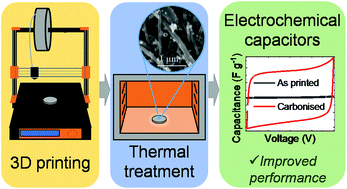3D-printing is an emerging technology that can be used for the fast prototyping and decentralised production of objects with complex geometries. Concretely, carbon-based 3D-printed electrodes have emerged as promising components for electrochemical capacitors. However, such electrodes usually require some post-treatments to be electrically active. Herein, 3D-printed nanocomposite electrodes made from a polylactic acid/nanocarbon filament have been characterised through different carbonisation temperatures in order to improve the conductivity of the electrodes via insulating polymer removal. Importantly, the carbonisation temperature has demonstrated to be a key parameter to tailor the capacitive behaviour of the resulting electrodes. Accordingly, this work opens new insights in advanced 3D-printed carbon-based electrodes employing thermal activation.
